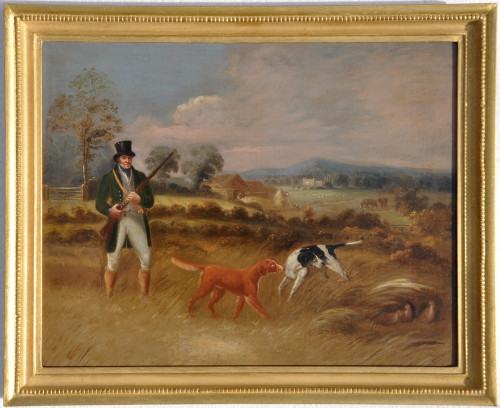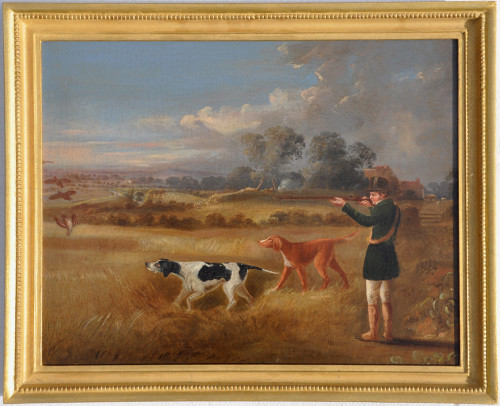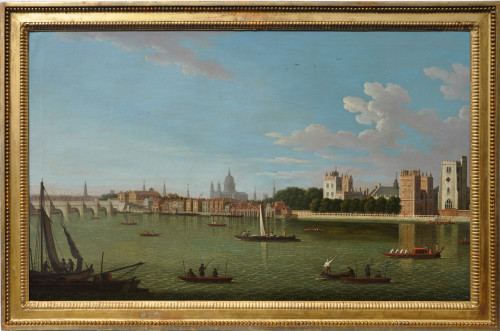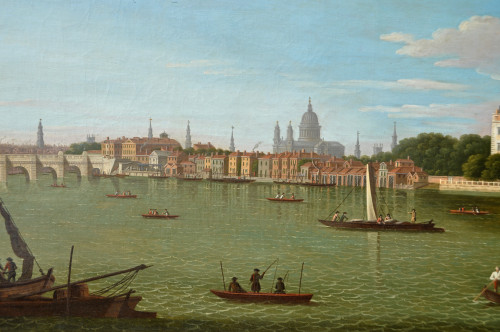A view on the River Thames with moored sailing boats and a view of the Royal Navy dockyard at Deptford on the far bank
A view on the River Thames with moored sailing boats and a view of the Royal Navy dockyard at Deptford on the far bank
WILLIAM ANDERSON
1757-1837
English School
A view on the River Thames with moored sailing boats and a view of the Royal Navy dockyard at Deptford on the far bank
Oil on canvas
63.7 x 76.3 cms
251/8 x 30 ins
Overall framed size 78.6 x 91 cms
31 x 35¾ins
M H Grant, writing in The Old English Landscape Painters Vol IV, says of William Anderson that: “He is assuredly one of the most delightful of our Little Masters. Immaculate paint, drawing clean and clear, a real ‘sweetness and amenity’ of colouring and handling, a charmingly old-world choice of and treatment of subject. All this, added to handy and portable dimensions of his normal panel or canvas, characterises the oeuvre of William Anderson.”
William Anderson was born in Scotland in 1757 and started employment as a shipwright in the Clyde shipyards. He came to London in 1787 with the intention of earning his livelihood as a marine draughtsman and lived at addresses in Lisson Grove and St. John’s Wood among others.
He clearly had an eye for detail and a natural ability to delineate ships but he does not seem to have had any formal instruction in painting. However, he was known to spend a considerable amount of time working at paintings and an observation was made by Edward Dayes, the watercolour painter and engraver that “…he employed his leisure hours in the art of painting.” His aptitude was remarkable for he soon forsook the dividers and rulers of his paid employment to set himself up as a marine painter, becoming one of the very best of that genre of painting.
Anderson was influenced by the Dutch Golden Age painters of the 17th century and his most characteristic work has an airy quality and a distinctive sense of colour that is soft and redolent of the great Dutch painter Jan van de Capelle. This aptitude translates perfectly when utilised in his best work which portrays ships in light airs and he was meticulous in his preparation for each work. One of his sketchbooks, probably from the years 1792-4, which is now in the collection of London’s Victoria and Albert Museum, is full of drawings in pencil and ink with depictions of merchant vessels and the careful delineation of the rigging, stern sections, prows and figureheads demonstrates his keen acuity for detail.
He exhibited his first work, A view on the Thames, at the Royal Academy when he was thirty years old and this was the start of a long association with both subject matter and exhibition venue as he showed at the R.A. a further 44 paintings, the last being a major work in 1834 with Lord Howe’s Fleet off Spithead.
The Thames formed a significant inspiration for his paintings throughout his career with examples of titles entered in exhibitions included several just as View on the Thames but others that were much more specific were: Shipping on the Thames at Deptford; View of Billingsgate at High Water; View of East Lane Stairs, Bermondsey; Scene on the Thames near Battersea; Troops embarking near Greenwich and Limehouse Reach. Occasionally, Anderson departed from marine painting and showed a landscape such as A woody scene with Gypsies and A view from the Painter’s window (ex. In 1832 when he was living in St John’s Wood, London). There was also the Battle of Waterloo shown in the B.I. in 1822.
However, Anderson also travelled to Holland and exhibited several paintings from these travels as well as views of Hastings and a period spent in the north-east depicting Berwick-on-Tweed, Tynemouth and Hull. His time spent in the last had a significant effect on the Hull school of painters, in particular the young John Ward (1798-1849) who came to be known as Ward of Hull. Julius Caesar Ibbetson, (1759-1817) the Leeds landscape painter, was a long-time friend and the former is thought to have collaborated with Anderson on a few paintings
The production of prints, fuelled by the public’s enthusiasm for having access to more affordable art, had been steadily increasing from the 18th century and in 1800 William Ellis issued a set of aquatints which were taken from the Battle of the Nile series of paintings that Anderson had painted. The painter had not actually witnessed the action but had based his portrayals on pencil sketches made by Colonel Walter Fawkes who had made the studies during the conflict.
A son, William Guido Anderson, also became an artist and exhibited a painting at the R.A. in 1799 with the title The Wolverine engaging two French luggers. He had joined the Royal Navy though and served as a midshipman on the Bellona but at the Battle of Copenhagen in 1801, he was mortally wounded.
Anderson exhibited 63 paintings in total, including 45 at the Royal Academy, between 1787 and 1834 with titles such as The Evening of February 14th, 1797, off Cape Vincent; View on the Thames - a Calm with Dutch boats; Scene off Gibraltar with a Frigate under Reef Topsails and Lord Howe’s Fleet off Spithead. Other paintings were exhibited at the Society of Artists (5), nine at the British Institution.
The Maritime Museum at Greenwich has nine of his paintings in its collection which includes a self-portrait. Many of his sketch books can be found in the Victoria and Albert Museum and the British Museum. Other museums and institutions which hold examples of his work include: Museum of London; National Army Museum; Government Art Collection; Walker Art Gallery, Liverpool; Sheffield Museum; Ferens Art Gallery; Leeds Museum and Art Gallery; Hall Place and Gardens; Beecroft Art Gallery; Maidstone Museum and Bentif Art Gallery; Dover Collections; Plymouth City Council; National Trust: Anglesey Abbey and Dorneywood; Yale Center for British Art has five works including A view of Westminster Bridge from the south side and also Hussars embarking at Deptford.
Edward Dayes, in his Professional Sketches, published in 1805, further commented that the artist was: “As a man he was singularly modest; and as an artist, the last to speak of his merits.” Regarding his artistic merits, Dayes goes on: “His style of colouring is clear and bright and his aerial perspective is well understood. The handling is clear, firm and decisive.”
William Anderson died on 27th May 1837.
Bibliography:
The Dictionary of British 18th Century Painters - Ellis Waterhouse
Marine Painting in England 1700-1900 – David Cordingly
Dictionary of British Marine Painters - Arnold Wilson
The Old English Landscape Painters – M H Grant
Watercolour Painting in Britain. The Eighteenth Century – Martin Hardie
Old and New London Vol. 6 – Edward Walford
DEPTFORD NAVAL DOCKYARD
The Naval Dockyard at Deptford on the River Thames was an important centre for the construction and maintenance of Royal Navy warships for 350 years and gained the epithet the “Cradle of the Navy”.
Deptford itself, known as Depeford in old English, earned its name from being a deep ford over the river Ravensborne close to where it joins the Thames. The town lies to the east of Rotherhithe with Greenwich further downstream.
The dockyard was founded in 1513 by Henry VIII although its origins go further back to the reign of Henry V when it had undertaken the building of royal ships at the very beginning of the 15th century. When Henry VII took the throne in 1485, he rented a storehouse for £5 at Deptford in 1487 but rather than developing the Thames site, he built the first royal dockyard at Portsmouth in 1496. His son, however, favoured the Thames as being more suitable for the navy with its proximity to London and apart from the Deptford site he also established Woolwich Dockyard in 1512 and Erith in 1514. Erith and Deptford were both centred round large storehouses which made good sense for the logistics of supply.
There is a still surviving foundation stone at the Great Store-house, dated 1513 with the date split by Henry VIII’s royal cypher, and this was a brick-built two-storey construction, 11 metres in height and 52 metres in length and lay parallel to the river. At right angles to this building was the Great Dock which was a double-length dry dock which was built at about the same time. There was also a wet dock of two acres for ships and another of an acre and a half. These were north-west of the Great Storehouse and had been developed from a pond which was fed by the small tributary the Orfleteditch.
In addition to the Store-house there were specialist timber stores and extensive other buildings for supplies and storage as well as dwelling houses for the officers who had to be on site at all time to administer construction and the supply chain. The requirement for housing for administrators had increased from the mid-16th century with the creation of the Navy Board and also necessitated the building of a residence suitable for the Treasurer of the Navy and continued to become more expansive as more officer’s clerks were taken on.
Deptford continued to expand throughout the 16th and 17th centuries, becoming not only a building ship yard but also encompassing the Victualling Yard and for a period it was the nerve centre of naval administration.
The association with royalty was a significant factor in Tudor times and both the sovereign and the navy understood this symbiotic relationship. The trialling of new ships was a good reason for the monarch to visit and to maintain this state of affairs it was necessary to make the visit as pleasurable as possible. To that end, in 1550, the Treasurer of the Navy authorised the expenditure of £88 so that Deptford High Street could be paved, because it had been “…previously so noisome and full of filth that the King's Majesty might not pass to and fro to see the building of his Highness's ships.”
In 1581 Elizabeth I knighted Francis Drake at the shipyard after his circumnavigation of the globe in the Golden Hind. She and her advisors understood the totemic message of this achievement and instructed that the ship be moored in Deptford Creek to be seen by the populace. It remained there for over eighty years before finally rotting away. The story of Sir Walter Raleigh laying down his cloak on muddy ground to enable the Queen to walk over it dry had the location as being Deptford but there are other contenders for the location. Peter the Great of Russia was a great admirer of the British Navy and in his drive for modernisation of his country visited the docks in 1698, but under an alias, in order to learn as much as he could of shipbuilding design and techniques. He stayed at the nearby Sayes Court which had been let to Admiral Benbow. The servant there wrote to the Admiral stating: “There is a house full of people and right nasty. The Tsar lies next your library, and dines in the parlour next your study. He dines at ten o'clock and at six at night, is very seldom at home a whole day, very often in the King's Yard or by water, dressed in several dresses.”
In 1730, an Act of Parliament divided Deptford into two parishes with the old town, which lay along the river, becoming St Nicholas. The author of Le Guide de l’Etranger à Londres, published in 1827, advised that for those travelling to London from Dover, this marked the last place to stay. He further goes on to note that there are two churches, that it is the location Henry VIII’s Royal Marine Arsenal where masts, cables anchors etc were manufactured and that the royal state yachts were kept there. He also mentions that to the north of Deptford was the Red House, the “grand depot of provisions for the fleet” which had burnt down in 1639 and again in 1761.
The yard continued to expand into the 18th century and despite the increase in importance of other yards such as Woolwich, Chatham and Sheerness, it remained a significant part of the navy’s development until after the Napoloenic War when with relative peace, fewer ships were required. In the Ambulator of 1774 it was written that: “Deptford is most remarkable for its noble dock, where the Royal Navy was formerly built and repaired, till it was found more convenient to build the larger ships at Woolwich, and at other places, where there is a greater depth of water.”
It was a popular view for marine artists to depict and, apart from William Anderson’s portrayals, Joseph Farington (1747-1821) painted an elevated view of the Dockyard (now in the National Maritime Museum), John Cleveley the Elder (c.1712-1777), his sons John (1747-1786) and Robert 1747-1809), Francis Holman and John Thomas Serres among others depicted the dockyard.
In 1821 the Admiralty decreed that from thenceforward, only minor maintenance work would be undertaken at Deptford although trial ships and experiments were still carried out, one of which was the launching the Navy’s first steam-powered ship the Comet in 1822. In the mid-19th century there was a brief rejuvenation of the yards but with the advent of iron clad warships, the construction of which Deptford was not a suitable site, it finally closed on 31st March 1869, marking the end of its place in English naval history and ensuing power.
RELATED ITEMS

























